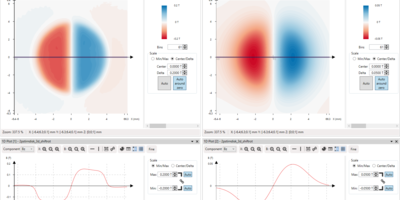Each permanent magnet’s shape and magnetization influence how it is used. It determines how magnetic field distributions are arranged outside the magnet and its magnetic field strength. There are, in general, four types of magnetizations: axial, radial, diametrical, and multi-pole. Depending on the material used and the application, the most common shapes of permanent magnets are rectangular, cylindrical, ring, spherical, bar, and disc in different sizes, varying from a few millimeters to decimeters.
Breadcrumb
How to inspect the magnetic field distributions of permanent magnets in different sizes, shapes, and types

Permanent magnets in different sizes, shapes, and types
Big magnets are stronger than small magnets, but not always. Their strength is dependent on the magnet material. Most permanent magnets are manufactured from one of these four materials: Neodymium-Iron-Boron (NdFeB), ceramic (ferrite), AlNiCo, and Samarium Cobalt (SmCo). NdFeB magnets are the most widely used type of rare earth magnets. These are strong enough to hold a large amount of flux without being too brittle, light enough to be easily molded into any shape, and can withstand high temperatures.
Three common magnetic field measurement systems
The demand for magnets has been increasing in several industries, such as sensor systems, actuator manufacturing, renewable energy sources, electronics, and medical devices. Especially in the electric motor industry, as one of the largest end consumers of permanent magnets, it plays a central role in positively impacting their demand due to urbanization, industrialization, clean transport, and the increasing demand for automation. Moreover, the expansion of wind power plants due to the growing population, climate change challenges, and increasing electricity demand is anticipated to drive market growth in the coming years.
Over one-third of the permanent magnet's production outputs have been used to manufacture various permanent magnet motors. The advantages include copper saving, power saving, weight reduction, small size, and high specific power. However, the design complexity and production tolerances are increasing to guarantee these motors' optimal operation and performance under all conditions. This means that magnetic field measurement equipment is necessary to measure and analyze the magnets' quality individually and within the end products. At present, several measurement systems can measure the magnetic field of magnets. These vary from a simple Gauss meter to an advanced multi-Hall sensor scanning system:

Gauss meter
A Gauss meter is a hand-held electronic device with a Hall sensor probe that measures the field strength perpendicular to the probe. On the probe's tip, a Hall sensor measures the voltage induced by the magnetic field, which is proportional to the magnetic flux density. The meter's display will show the Gauss field value. Depending on the measurement types, there are different probes, such as axial or transverse probes.
When measuring the magnetic field of a magnet with a Gauss meter, several factors affect the measurement result, such as the probe's orientation relative to the magnet and the distance to the magnet. High-accuracy positioning is thus required to get good results. This is particularly difficult for magnets with an inhomogeneous magnetic field distribution, such as multipole magnets, since small position changes can significantly influence the measured magnetic field.

Flux meter
A flux meter (Helmholtz coil meter) is designed to measure the amount of magnetic flux generated from a magnetic surface of a permanent magnet. It's used in physics labs to test the properties of materials. With a flux meter, a permanent magnet can be characterized by simply passing through the center of a Helmholtz coil with an open center volume based on a physical relationship between the number of windings of the coils and the variation of magnetic flux across the coils.
A flux meter is more challenging to use and more complex than a Gauss meter.
In short, a Gauss meter and flux meter are suitable devices for measuring a few basic properties of a magnet, such as the magnetic field peak value and the magnetic flux. However, with hand-held instruments, the results can be somewhat inaccurate. The software with these instruments is rather basic. These measurement systems cannot answer all the complex questions about magnetic issues related to individual magnets, such as inhomogeneities, North/South asymmetries, and magnetic problems inherent to rotor assemblies of magnets, such as the NVH issues (the noise, vibration, and harshness issues).
Advanced magnetic field scanner
Magcam’s advanced magnetic field scanner (Combi Scanner), a 4-axis motorized scan stage, is designed to measure the magnetic field distributions of permanent magnets in different types, shapes, and sizes. From individual magnets and magnet assemblies to permanent magnet rotors (radial and axial). The Combi Scanner can map 3D magnetic fields with high accuracy and spatial resolution thanks to a built-in magnetic field camera. It features an advanced on-chip 2D array of Hall sensors with more than 16000 measurement points.
The Combi Scanner has two measurement modes:

Portal mode for flat magnets and magnet assemblies
In the portal mode, the magnetic field camera is pointed downwards to measure the magnetic field distributions of flat magnets and magnetic assemblies from a few millimeters in size up to 290mm x 290mm x 250mm (WxDxH).
The magnetic field camera can measure large magnetic areas at high speed. It is about 30 times faster than single-probe equipment. The distance between the camera and the magnet can be as close as 0.5mm, guaranteeing the best magnetic field accuracy (the best signal-to-noise ratio). With MagScope, Magcam's in-house developed software, it becomes possible to completely automate the measurement and analysis procedure. A magnet's measured full magnetic field distribution contains a large amount of information about the magnet's properties and quality. MagScope includes lots of analysis functions to extract the relevant properties of a magnet for any application.

Rotor mode for PM rotors, ring magnets, and circular magnetic assemblies
A rotary stage is added in rotor mode. The 3D magnetic field camera is pointed forwards to measure radial permanent magnet rotors (up to 500mm diameter and 290mm axial length) and curved magnet segments.
Magcam's magnetic field scanner can measure the magnetic field distribution on the entire rotor surface with high axial and angular resolutions at close radial distances in seconds. A complete analysis of the rotor can be performed with the MagScope software to determine North/South pole symmetry, automatic pole measurement/count, Fourier analysis of harmonics for noise, vibration, cogging torque analysis, material defects, and much more. Curved magnet segments can be placed in a holder and measured similarly to rotors.
For other specific magnets, such as tiny flat magnets (~1mm), large industrial motors, large wind turbine magnets, and outer or inner permanent magnet rotors, Magcam has other solutions providing high-accurate- and high-speed measurements, suitable for production, quality control, and R&D environments.
Magcam experts can assist in selecting the best magnetic field measurement solution for your situation.


